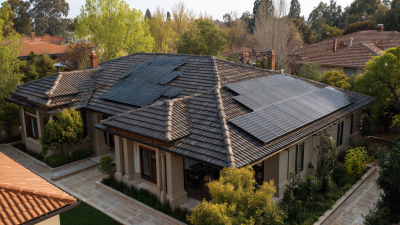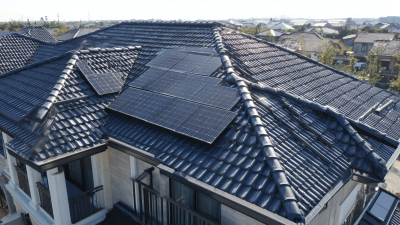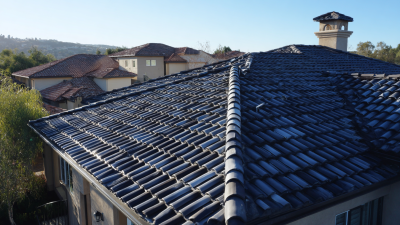Innovative Solutions for Harnessing Energy with Photovoltaic Tiles
As the global demand for renewable energy sources continues to escalate, innovative solutions such as photovoltaic tiles are emerging as a promising avenue for harnessing solar energy. According to the International Energy Agency, solar energy could account for as much as 27% of global electricity generation by 2050, and advancements in technologies like photovoltaic tiles are pivotal in reaching that target. These tiles not only integrate seamlessly into building designs, providing aesthetic value, but also enhance energy efficiency by converting sunlight directly into electricity.

A recent report by Grand View Research predicts that the global market for building-integrated photovoltaics, which includes photovoltaic tiles, will grow at a compound annual growth rate of 20.9% from 2021 to 2028. This guide will explore the innovative applications and benefits of photovoltaic tiles, showcasing how they are set to revolutionize the way we think about energy generation in urban environments.
Understanding Photovoltaic Tiles: How They Work and Their Benefits
Photovoltaic tiles represent a major innovation in the solar energy landscape, seamlessly integrating renewable energy technology into building designs. These tiles work by converting sunlight into electricity, operating similarly to traditional solar panels but with enhanced aesthetics and versatility. Unlike conventional solar panels that can dominate a rooftop's appearance, photovoltaic tiles resemble standard roofing materials, allowing homeowners to maintain their architectural vision while reaping the benefits of solar energy. Their sleek design encourages broader adoption among those who prioritize aesthetics alongside functionality.
The benefits of photovoltaic tiles extend beyond just visual appeal. They can contribute significantly to energy efficiency in buildings. Recent advancements have led to the development of systems that combine photovoltaic technology with thermal components, optimizing energy production. For instance, some tiles can now be connected to heat pumps, allowing for smart energy management and higher efficiency in temperature regulation. As more buildings incorporate these innovative systems, they not only enhance green credentials but also create pathways toward sustainable energy independence. This synergy between design and function underlines the future direction of solar technology, making clean energy accessible and appealing to a wider audience.

Innovative Applications of Photovoltaic Tiles in Urban Design
The integration of photovoltaic (PV) tiles in urban design represents a paradigm shift in how cities can harness renewable energy. With the global solar energy market expected to grow from $200 billion in 2021 to over $600 billion by 2028, according to a report by Fortune Business Insights, the potential for PV tiles to significantly impact urban infrastructure is substantial. These tiles not only serve the dual purpose of providing energy but also enhance the aesthetic appeal of buildings, blending seamlessly with traditional roofing materials.
Moreover, cities are increasingly adopting PV tiles as part of their sustainable development strategies. For instance, cities like Freiburg in Germany and San Diego in the USA have incorporated solar tiles into their architectural guidelines, resulting in a significant increase in energy efficiency. A study by the International Energy Agency indicates that integrating PV tiles can increase a building’s energy output by 15-30% compared to conventional roofing systems. This innovative approach not only contributes to the reduction of carbon footprints but also promotes energy independence for urban areas, allowing them to harness their own renewable energy sources effectively.

Choosing the Right Photovoltaic Tiles for Your Energy Needs
When considering photovoltaic tiles for your energy needs, it’s essential to understand the types available and their efficiency ratings. According to the International Renewable Energy Agency (IRENA), building-integrated photovoltaics (BIPV), including tiles, can yield up to 60% more energy per square meter compared to traditional rooftop panels when integrated correctly. This makes choosing the right photovoltaic tiles a crucial decision for homeowners and builders aiming for sustainable energy solutions.
**Tips for Selection:** Look for photovoltaic tiles that offer high efficiency ratings—ideally above 20%—as well as durability to withstand environmental stress. Many manufacturers now provide warranties exceeding 25 years, ensuring long-term performance. Additionally, consider aesthetic options; many advanced photovoltaic tiles mimic traditional roofing materials, allowing you to maintain your home's visual appeal while reaping energy benefits.
Another critical consideration is the installation process. Some tiles are designed for easy integration into existing roofs without extensive structural changes, potential reducing installation costs and time. A recent report by the U.S. Department of Energy highlights that proper installation can enhance energy output by as much as 30%. Prioritize working with experienced contractors who understand the specific requirements of photovoltaic tile installation to maximize energy production and longevity.
Innovative Solutions for Harnessing Energy with Photovoltaic Tiles
| Tile Type | Efficiency (%) | Cost per Square Meter ($) | Lifespan (Years) | Installation Difficulty |
|---|---|---|---|---|
| Monocrystalline | 15-22 | 150-250 | 25-30 | Medium |
| Polycrystalline | 13-16 | 100-200 | 20-25 | Easy |
| Bifacial | 15-20 | 180-300 | 25-30 | Hard |
| Thin-film | 10-12 | 70-150 | 15-20 | Very Easy |
| Building-integrated (BIPV) | 8-15 | 200-500 | 20-25 | Medium |
Installation Techniques for Maximizing Efficiency of PV Tiles
When it comes to installing photovoltaic (PV) tiles, the right techniques can significantly enhance energy efficiency and overall performance. First and foremost, selecting the optimal orientation and tilt angle is crucial. Positioning PV tiles to face the sun's path maximizes exposure to sunlight throughout the day. Areas with frequent shading—like those near trees or taller buildings—should be carefully examined to ensure that the tiles receive unobstructed sunlight for the longest periods possible.
Another important aspect is the installation method itself. Utilizing a professional-grade mounting system that accommodates both flat and sloped roofs can not only streamline the installation process but also improve the durability of the tiles against varying weather conditions. Additionally, incorporating advanced technologies such as microinverters or power optimizers can enhance energy output by ensuring that each tile operates at peak efficiency, even when some tiles may be partially shaded or less effective.
Through these techniques, homeowners and builders can maximize the benefits of PV tiles, contributing to sustainable energy solutions in our everyday lives.
Future Trends: Advances in Photovoltaic Tile Technology and Their Impact
The advancements in photovoltaic (PV) tile technology are poised to revolutionize the solar energy landscape as the world shifts towards more sustainable energy solutions. As reported by the International Renewable Energy Agency (IRENA), the global solar energy capacity has surged to over 1,000 GW, with PV tiles emerging as a versatile alternative to traditional solar panels. These tiles not only integrate seamlessly into architectural designs but also offer enhanced efficiency rates, now reaching up to 20% according to recent studies from the National Renewable Energy Laboratory (NREL).
Looking ahead, the future of photovoltaic tiles is bright, with innovations such as BIPV (Building-Integrated Photovoltaics) gaining traction. This technology allows buildings to generate their own energy while maintaining aesthetic appeal. Market research by Allied Market Research projects that the global BIPV market will reach $107 billion by 2028, driven by increasing awareness of energy efficiency and integration within urban infrastructure. The dual functionality of PV tiles—serving both as roofing materials and energy generators—highlights an exciting trend where sustainability meets practicality, setting the stage for smarter cities and enhanced energy autonomy.
Related Posts
-

Navigating Import and Export Certifications for the Best PV Tiles in the Global Market
-

The Future of Sustainable Living with Solar Roof Tiles
-

15 Top Reasons to Choose Best Solar PV Roof Tiles for Sustainable Energy Solutions
-

How to Maximize Efficiency with Solar Thermal Panels in Your Home
-

Exploring the Revolution: What are Solar Cell Roof Tiles and Their Benefits?
-

Top Strategies for Maximizing Efficiency with Best Solar Panel Roof Tiles